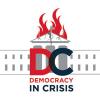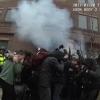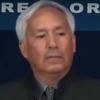Trump's Police State Is Already Here
Democracy in Crisis

In police body-camera footage obtained by Democracy in Crisis, the scene in Washington, DC on Jan. 20 shows the war zone our nation really is right now. The balance of power in the battle—both on the streets then and in the courts today—is deeply asymmetrical, with the police and the government struggling to maintain control of all information related to the case.
This video is part of the vast digital archive of possible evidence in the case against more than 200 people facing decades in jail on charges of felony rioting, conspiracy to riot, inciting riot and property damage.
In the footage, a crowd comes around the corner carrying a large banner and many smaller signs and flags, wearing black jackets, hoodies and masks over their faces. As the group moves down the street, police on motorcycles and bicycles pursue them. One cop is pulled off of his bike, and newspaper boxes and trash cans fly into the street until the crowd is eventually kettled—pushed into a confined area with pepper spray, tear gas and other displays of force by police officers.
The motorcycle cop from whose point of view the events unfold is holding a baton with both gloved hands, using it to pen in protesters. “You’re all in a bad spot,” the officer says. “And you put yourself there. Do you understand that?” He holds his stick against a man’s body.
He keeps pushing people. “Fall out if that’s what you need to do,” he says as a man with a masked face motions toward him. “You are a threat,” the officer hollers, and seems to hit the man with his stick. Then another officer pepper-sprays the crowd. Yet another pushes a protester into a tree. Plumes of chemical smoke rise above them as a flag flutters from the side of the building they are jammed up against. The officer tells the protesters not to clean their eyes and orders them to put their hands up, as they try to wash each others’ faces with water.
No one disputes the fact that property was damaged that day, or that police officers were injured. “Most of what occurred that day, if not all, was caught on some sort of video,” says Christopher Gowan, a law professor at American University and lawyer appointed to one of the defendants in the case. “Evidence is out there for the government to say, ‘This person is culpable of rioting, and this person clearly is not.’”
A 31-year-old Army vet and activist named Dane Powell pleaded guilty to two felony charges of rioting and assaulting a police officer in April. On July 7, he was sentenced to 36 months for each charge, with all but four suspended. In Powell’s case, the government had video evidence that showed him breaking windows of a Starbucks and throwing rocks at police officers, although they could not prove that any of his projectiles actually harmed anyone. “He’s not one of the persons whose participation was limited to marching, chanting or wearing black,” Judge Lynn Leibovitz said.
Prosecutor Jennifer Kerkhoff agreed, noting that Powell’s case was “not about wearing black… not about wearing a mask.” But a majority of the cases are about precisely that.
If Powell broke a certain window, 200 other people didn’t. But the government contends that wearing black in the vicinity of a black bloc action is evidence of criminal conspiracy. Jason Flores-Williams, a lawyer working for three defendants in the case, filed a motion pleading that the prosecution is illegal under the principle of strictissimi juris.
He explains the legal term: “When a fundamental right is at stake, like the First Amendment, then the government has a heightened duty to provide direct evidence against the people it is prosecuting, because if you don’t provide that direct evidence, then you run a serious risk of violating—and essentially gutting—a constitutional right by a criminal indictment, which is essentially what is happening in this case.”
Supporting the assault charge against Powell, the government cited the fact that he and others broke the police line as they were being kettled. The same language is used in the indictments against more than 200 defendants. Just after the 1:10 mark on the video, however, it appears that two streams of pepper spray are released at the left of the screen, before anyone begins to run, potentially pushing them toward the line.
Surely there is more police footage from the officers behind the protesters. We need to see it in order to know precisely what happened. Kerkhoff has filed a protective order to prevent defendants from sharing discovery with the press or civil attorneys, which would keep the public from knowing what the police, who were also dressed in identical clothing and covering their faces, did that day. The judge has not yet ruled on the protective order, but we will keep releasing the material we have obtained, while being careful—as were our sources—to protect the privacy of individuals.
A report by the Police Complaints Board and a civil suit filed by the ACLU detail some of the worst behavior of police officers, but it is vital for the public to actually see the state of dissent in America. This mass prosecution is a greater threat to the First Amendment rights than any anti-CNN meme the president might tweet. The thing you’re worried about is already happening.
“What the government is trying to do is send the message out… and say if you get anywhere near a protest that might be more than standing with your head lowered in a free speech zone like cattle… then you run the risk of being charged with a felony,” Flores-Williams says.
More by Baynard Woods
-

With Much Love and Grim Solidarity, Democracy in Crisis Says Goodbye
Democracy in Crisis
-

Trump Uses the Legal System for His Own Ends
Democracy in Crisis
-

A Mexican Reporter's Death Threats Are the Future of Journalism in America
Democracy in Crisis









comments